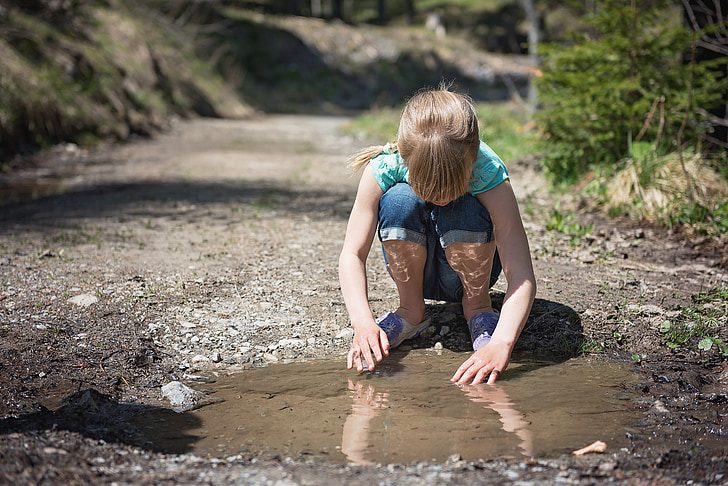6 ways to complete an in-depth puddle investigation-

- How deep is the puddle?
- March right in and measure with your feet/legs/boots
- Use a nature measuring stick (learn how to easily make your own)
- Use conventional measurement tools like rulers, metric sticks
- Record your results
- How big is the puddle?
- Use a ruler, yard stick or metric stick to measure the length of your puddle
- Use a long string to form an outline of the puddle and then measure it to find the circumference of your puddle
- Record you results.
It is fun to track the differences in the puddle stats over time so keep a record of daily or hourly changes.
- What shape is the puddle?
- If your puddle is on a hard surface like a sidewalk or driveway you can draw around the puddle with chalk, but if your puddle is in dirt or mud, use a stick to draw around the shape of the puddle
- Look at your puddle from above, from beside and from inside the puddle
- Draw the shape of your puddle in your journal
- Use words to describe your puddle’s shape
Keep checking & drawing your puddle shape. Does the shape change over time? What does it look like when water is gone? Will a puddle form here again?
- Who uses the puddle?
- Predict what critters might use your puddle
- What would they use the puddle for? (drinking, bathing, splashing fun?)
- Keep an observation guide to record which critters were in or near the puddle and how they were using the puddle
- Does the puddle have a current?
Make a boat from bark, nuts & other natural materials, create a foil boat or make one from recycled plastic
- Sail your boat in the puddle
- Can you get it to sail from one side of the puddle to the other?
- Observe the natural boat movements (without humans touching the sailboat)
- What forces make the boat move?
- Problem Solving: How can you get water out of the puddle?
Let learners brainstorm and figure out a way to get the water out of the puddle-
- Have some materials handy in case learners need it for their plan (sponges, cups, pipettes & a variety of materials for exploration)
- Rubber boots and stomping is a really fun way to get the water out!
Nature-based Stick Rulers
- Find a nice straight stick (a straight stick is best for measuring)
- Line up your stick next to your ruler and use clippers to cut the stick 12 inches long
- Add lines at each of the inch (and if you would like half inch) marks with a permanent marker or by carving notches into it using a ruler as a guide
Get your child excited about measuring!
Take your child on a hike with their new ruler stick and let them stop and measure things along the way (build those math skills!). Perhaps even add some literacy to their hike by bringing a notebook and recording all their measurements.
Idéa taken from Puddle Scientist — Learning withOutdoors
